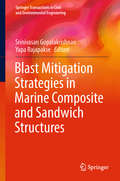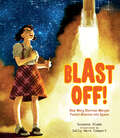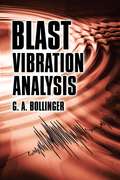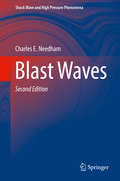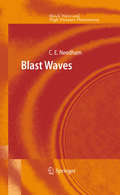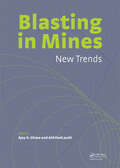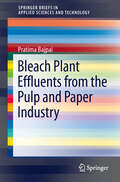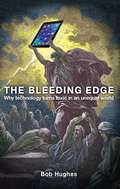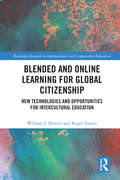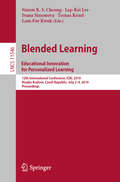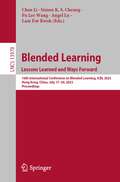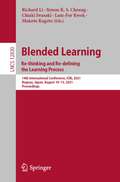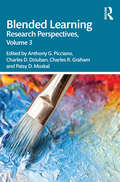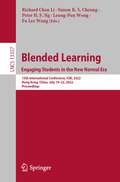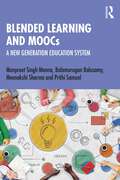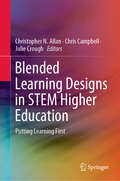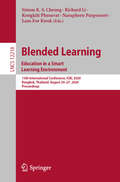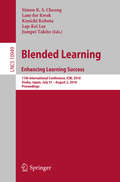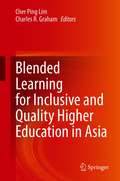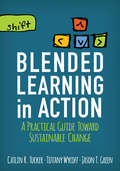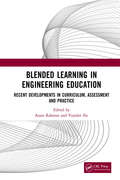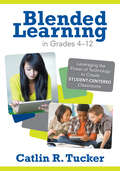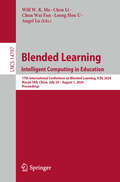- Table View
- List View
Blast Mitigation Strategies in Marine Composite and Sandwich Structures (Springer Transactions in Civil and Environmental Engineering)
by Srinivasan Gopalakrishnan Yapa RajapakseThis book primarily focuses on methodologies to enable marine structures to resist high velocity impact loadings. It is based on invited talks presented at the recent India-USA workshop on "Recent Advances in Blast Mitigation Strategies in Civil and Marine Composite Structures" The book comprises content from top researchers from India and the USA and covers various aspects of the topic, including modeling and simulation, design aspects, experimentation and various challenges. These failure modes significantly reduce the structural integrity of the marine structures unless they are designed to resist such harsh loadings. Understanding the mechanics of these structures under harsh loadings is still an open area of research, and the behavior of these structures is not fully understood. The book highlights efforts to reduce the effects of blast loadings on marine composite structures. Intended for researchers/scientists and practicing engineers, the book focuses not only the design and analysis challenges of marine composite structures under such harsh loading conditions, but also provides new design guidelines.
Blast Off!: How Mary Sherman Morgan Fueled America into Space
by Suzanne SladeThe inspirational story of Mary Sherman, the world's first female rocket scientist, who overcame gender barriers and many failures to succeed.Growing up in the 1920s on a dirt-poor farm in North Dakota, Mary Sherman's life was filled with chores--until she finally began school and discovered she loved to learn. Mary excelled at science, especially chemistry, and leaped at the chance to work in a laboratory during World War II designing rocket fuels. And when the US decided to enter the space race, Mary was chosen over her male colleagues to create the fuel to launch a rocket carrying America's first satellite. With courage and perseverance, Mary's hard work and calculations paid off, opening up a brand-new frontier for exploration. This STEM biography of an unsung and courageous woman in science will inspire and motivate young readers.
Blast Vibration Analysis (Dover Books on Engineering)
by G. A. BollingerFor the comprehension and analysis of blast vibrations, scientists and engineers require a sophisticated understanding of wave phenomena. Blast Vibration Analysis makes an important contribution to studies of the subject by focusing on the origin, transmission, and types of elastic wave in solid media. The approach covers physical laws involved in wave analysis as well as the mathematical tools needed to specify and analyze the variety of wave phenomena encountered in nature.G. A. Bollinger, a former professor of geophysics at Virginia Polytechnic Institute and State University, applies the analytical tools that have been so highly refined in earthquake engineering, earthquake seismology, and seismic exploration for petroleum — i.e., digital and spectral analyses — to the blast vibration problem. The text starts at an elementary level, carries the exposition to an intermediate level, and indicates the direction of more advanced consideration. Many informative tables, figures, graphs, charts, mathematical examples, and photographs of instruments appear throughout. Advanced undergraduate students, graduate students, and professionals in engineering and physics will find this treatment stimulating and suggestive of further areas of study and practice.
Blast Waves (Shock Wave and High Pressure Phenomena)
by Charles E. NeedhamAs an editor of the international scienti?c journal Shock Waves, I was asked whether I might document some of my experience and knowledge in the ?eld of blast waves. I began an outline for a book on the basis of a short course that I had been teaching for several years. I added to the outline, ?lling in details and including recent devel- ments, especially in the subjects of height of burst curves and nonideal explosives. At a recent meeting of the International Symposium on the Interaction of Shock Waves, I was asked to write the book I had said I was working on. As a senior advisor to a group working on computational ?uid dynamics, I found that I was repeating many useful rules and conservation laws as new people came into the group. The transfer of knowledge was hit and miss as questions arose during the normal work day. Although I had developed a short course on blast waves, it was not practical to teach the full course every time a new member was added to the group. This was suf?cient incentive for me to undertake the writing of this book. I cut my work schedule to part time for two years while writing the book. This allowed me to remain heavily involved in ongoing and leading edge work in hydrodynamics while documenting this somewhat historical perspective on blast waves.
Blast Waves (Shock Wave and High Pressure Phenomena)
by Charles E. NeedhamThe primary purpose of this text is to document many of the lessons that have been learned during the author's more than forty years in the field of blast and shock. The writing therefore takes on an historical perspective, in some sense, because it follows the author's experience. The book deals with blast waves propagating in fluids or materials that can be treated as fluids. It begins by distinguishing between blast waves and the more general category of shock waves. It then examines several ways of generating blast waves, considering the propagation of blast waves in one, two and three dimensions as well as through the real atmosphere. One section treats the propagation of shocks in layered gases in a more detailed manner. The book also details the interaction of shock waves with structures in particular reflections, progressing from simple to complex geometries, including planar structures, two-dimensional structures such as ramps or wedges, reflections from heights of burst, and three-dimensional structures. Intended for those with a basic knowledge of algebra and a solid grasp of the concepts of conservation of mass and energy, the text includes an introduction to blast wave terminology and conservation laws as well as a discussion of units and the importance of consistency.
Blasting in Mining - New Trends
by Ajoy K. Ghose Akhilesh JoshiBlasting practices in mines have undergone many changes in the recent past and continue to be honed and reconfigured to meet the demands of today�s mining needs. This volume compiles papers of the workshop Blasting in Mines � New Trends, hosted by the Fragblast 10 Symposium . The 17 papers provide a mix which highlight the evolving trends in blasti
Bleach Plant Effluents from the Pulp and Paper Industry (SpringerBriefs in Applied Sciences and Technology)
by Pratima BajpaiThis book covers bleach plant effluents, that most polluting effluent from the pulp and paper industry. Disappearance of benthic invertebrates, a high incidence of fish diseases, and mutagenic effects on the aquatic fauna are some of the consequences of the disposal of bleach effluents into surface waters. This book describes environmental impact of bleach plant effluents, environmental regulations, and measures to reduce the pollution load by internal process modification and external treatment of bleach plant effluents.
The Bleeding Edge: Why Technology Turns Toxic in an Unequal World
by Bob Hughes<P>Capitalism likes us to believe in the steady, inevitable march of progress, from the abacus to the iPad. But the historical record tells of innumerable roads not taken, all of which could have led to better, more equal worlds, and still can. <P>Academic and activist Bob Hughes puts flesh on the bones of the idea that 'another world is possible', using as evidence the technology that capitalism claims as quintessentially its own: the computer in all its forms. <P>Contrary to popular belief capitalism does not do innovation well - instead suppressing or appropriating it. This book shows that great innovations have never emerged from capitalism per se, but always from the utopian moments that occur behind the capitalist's back. And when it does embrace an innovation, the results are often the diametric opposite of what the innovators intended.In this thorough and meticulous work Hughes argues that if we only prioritized equality over materialism then superior and more diverse technologies would emerge leading to a richer more sustainable world. <P>Bob Hughes is an academic, activist, and author. Formerly he taught electronic media Oxford Brookes University and now spends his time researching and campaigning against inequality. He is author of Dust or Magic, a book for digital multimedia workers, about how people "do good stuff with computers." He is a member of No One is Illegal, which campaigns for the total abolition of immigration controls, for whom he has written many articles.
Blended and Online Learning for Global Citizenship: New Technologies and Opportunities for Intercultural Education (Routledge Research in International and Comparative Education)
by Roger Austin William J. HunterBy showcasing international, European, and community-based projects, this volume explores how online technologies and collaborative and blended learning can be used to bolster social cohesion and increase students’ understanding of what it means to be a global citizen. With the pace of technology rapidly increasing, Blended and Online Learning for Global Citizenship draws timely attention to the global lessons being learned from the impact of these technologies on peace building, community development, and acceptance of difference. In-depth case studies showcasing successful projects in Europe, Northern Ireland, and Israel explore blended learning and illustrate how schools and educators have embraced online technologies to foster national and international links both within and beyond communities. This has, in turn, equipped students with experiences that have informed their attitudes to cultural and political conflicts, as well as racial, ethnic, and social diversity. Building on the authors’ previous work Online Learning and Community Cohesion (2013), this thought-provoking text will be of interest to researchers, academics, and postgraduate students in the fields of international and comparative education. Educators and school leaders concerned with how multiculturalism and technology play out in the classroom environment will also benefit from reading this text.
Blended Learning: 12th International Conference, ICBL 2019, Hradec Kralove, Czech Republic, July 2–4, 2019, Proceedings (Lecture Notes in Computer Science #11546)
by Simon K. Cheung Lap-Kei Lee Ivana Simonova Tomas Kozel Lam-For KwokThis book constitutes the refereed proceedings of the 12th International Conference on Blended Learning, ICBL 2019, held in Hradec Kralove, Czech Republic, in July 2019. The 28 papers presented were carefully reviewed and selected from 80 submissions. The papers are organized in topical sections named: personalized and adaptive learning; content development for blended learning; experience in blended learning; analytics and evaluation for blended learning; open educational resources; and pedagogical and psychological issues.
Blended Learning: 16th International Conference on Blended Learning, ICBL 2023, Hong Kong, China, July 17-20, 2023, Proceedings (Lecture Notes in Computer Science #13978)
by Chen Li Simon K. S. Cheung Fu Lee Wang Angel Lu Lam For KwokThis book constitutes the refereed proceedings of the 16th International Conference on Blended Learning, ICBL 2023, held in Hong Kong, China, on July 17-20, 2023. The 24 papers presented in this volume were carefully reviewed and selected from 57 submissions. The papers are organized in topical sections named: smart classroom and digital literacy; online and distant learning; content and pedagogy development for blended learning; gamification and lnteractive learning snvironment; learning analytics and big data in education.
Blended Learning: 14th International Conference, ICBL 2021, Nagoya, Japan, August 10–13, 2021, Proceedings (Lecture Notes in Computer Science #12830)
by Richard Li Simon K. S. Cheung Chiaki Iwasaki Lam-For Kwok Makoto KagetoThis book constitutes the refereed proceedings of the 14th International Conference on Blended Learning, ICBL 2021, held online in August 2021. The 30 papers, including 4 keynote papers, were carefully reviewed and selected from 79 submissions. The conference theme of ICBL 2021 is Blended Learning: Re-thinking and Re-defining the Learning Process. The papers are organized in topical sections named: content and instructional design; enriched and smart learning experience; experience in blended learning; institutional policies and strategies; and online and collaborative learning.
Blended Learning: Research Perspectives, Volume 3
by Anthony G. Picciano Charles D. Dziuban Charles R. Graham Patsy D. MoskalBlended Learning: Research Perspectives, Volume 3 offers new insights into the state of blended learning, an instructional modality that combines face-to-face and digitally mediated experiences. Education has recently seen remarkable advances in instructional technologies such as adaptive and personalized instruction, virtual learning environments, gaming, analytics, and big data software. This book examines how these and other evolving tools are fueling advances in our schools, colleges, and universities. Original scholarship from education’s top thinkers will prepare researchers and learning designers to tackle major issues relating to learning effectiveness, diversity, economies of scale, and beyond.
Blended Learning: 15th International Conference, ICBL 2022, Hong Kong, China, July 19–22, 2022, Proceedings (Lecture Notes in Computer Science #13357)
by Fu Lee Wang Simon K. S. Cheung Richard Chen Li Peter H. F. Ng Leung-Pun WongThis book constitutes the refereed proceedings of the 15th International Conference on Blended Learning, ICBL 2022, held in Hong Kong, China, in August 2022. The 31 papers presented in this volume were carefully reviewed and selected from 80 submissions. The conference theme of ICBL 2022 is Blended Learning: Engaging Students in the New Era. The papers are organized in topical sections named: Game-based Learning and Augmented Learning Environment; Computer Supported Collaborative Learning; Enriching Learning Experience with Blended and Online Learning; Content Development and Practice for Blended Learning and Beyond.
Blended Learning and MOOCs: A New Generation Education System
by Manpreet Singh Manna Balamurugan Balusamy Meenakshi Sharma Prithi SamuelThis book presents a framework for integrating blended learning and massive open online courses (MOOCs) in the Indian education system. It argues that blended teaching and learning is the most suitable approach to education in a post-COVID-19 world. Drawing on case studies used in blended learning practices around the world, the book provides ample resources for beginners to improvise the spread of knowledge around information technology in higher education. It discusses various concepts such as flip learning in blended learning models and examines the self-assessment tools and structures it offers to institutions for building competencies. In addition to addressing the challenges and opportunities of adopting the digital mode of teaching, the book also offers techniques and concepts helpful for designing MOOCs. It covers concepts such as curriculum designing, content flow, teaching behavior, and evaluation patterns, which are important aspects of online teaching. An indispensable guide to navigating the shift from offline to online teaching, this book will be of interest to students, teachers, and researchers of education, education technology, digital education, and information technology. It will also be useful to policymakers, educational institutions, EdTech start-ups, NGOs in the education sector, and online education centers.
Blended Learning: Convergence between Technology and Pedagogy (Lecture Notes in Networks and Systems #126)
by Antonio Víctor Martín-GarcíaThis book focuses on essential aspects of the theoretical foundations that support blended learning (BL) as a teaching training modality in tertiary education. Analyzing the changes in the world of education that lead to new ways of thinking and learning, it redefines the concept of blended learning at a time of constant growth in many universities around the world. This involves a shared reflection on the role of technology in the current university teacher education programs, as well as on the role that pedagogy plays in increasingly technology-driven contexts. Furthermore, the book presents pedagogical approaches to guide university professors in the design and implementation of blended learning courses. To this end, it describes some of the major models and approaches to BL instructional design, and examines issues related to the quality of BL training and the indicators to measure it, in order to identify those models that contribute to a better understanding of the dimensions that increase its effectiveness.
Blended Learning Designs in STEM Higher Education: Putting Learning First
by Christopher N. Allan Chris Campbell Julie CroughThis book offers a set of learning principles to support the design of rich learning experiences in Science, Technology, Engineering and Mathematics (STEM) higher education, including detailed evaluations and discussions for a variety of science subjects. Further, it presents a professional learning framework that can be used to support the implementation of blended learning technologies to increase buy-in from academic staff, to support grass roots initiatives, to develop a sense of community, and to sustain change. The principles developed here will help readers to think about blended learning from a learner’s perspective, put learning first, and develop activities that will help learners achieve better learning outcomes.In addition, the book addresses how to design rich, evidence-based, blended learning experiences that support learning. It demonstrates a range of learning principles in practice, with step-by-step instructions, and includes templates, supporting material, instructions and other resources to help teachers embed and adapt designs in their own subject. Readers will be equipped with an expanded toolkit of resources, designs, ideas and activities that can be directly applied in a variety of subject areas.
Blended Learning. Education in a Smart Learning Environment: 13th International Conference, ICBL 2020, Bangkok, Thailand, August 24–27, 2020, Proceedings (Lecture Notes in Computer Science #12218)
by Richard Li Simon K. S. Cheung Kongkiti Phusavat Naraphorn Paoprasert Lam‑For KwokThis book constitutes the refereed proceedings of the 13th International Conference on Blended Learning, ICBL 2020, held in Bangkok, in August 2020.The 33 papers presented were carefully reviewed and selected from 70 submissions. The conference theme of ICBL 2020 is Blended Learning : Education in a Smart Learning Environment. The papers are organized in topical sections named: Blended Learning, Hybrid Learning, Online Learning, Enriched and Smart Learning, Learning Management System and Content and Instructional Design.
Blended Learning. Enhancing Learning Success: 11th International Conference, ICBL 2018, Osaka, Japan, July 31- August 2, 2018, Proceedings (Lecture Notes in Computer Science #10949)
by Simon K.S. Cheung Lam-For Kwok Kenichi Kubota Lap-Kei Lee Jumpei TokitoThis book constitutes the refereed proceedings of the 11th International Conference on Blended Learning, ICBL 2018, held in Osaka, Japan, in July/ August 2018.The 35 papers presented were carefully reviewed and selected from 94 submissions. The papers are organized in topical sections named: Experiences in Blended Learning, Content Development for Blended Learning, Assessment for Blended Learning, Computer-Support Collaborative Learning, Improved Flexibility of Learning Processes, Open Educational Resources, and Pedagogical and Psychological Issues.
Blended Learning for Inclusive and Quality Higher Education in Asia
by Charles R. Graham Cher Ping LimThis book demonstrates how blended learning improves access to and enhances the quality of higher education teaching and learning in Asian universities. It first discusses how leading universities in the region drive and support blended learning at the institutional level to enhance student learning engagement and outcomes. It then examines 10 effective implementations and lessons learned of blended learning practices across different disciplinary courses and programmes (humanities and language, science and engineering, social science and education, and others) in the region. The chapters in this book provide an overview of the opportunities and challenges of blended learning for improved access and enhanced quality of higher education, and offer insights into the promising blended learning policies and practices in Asian universities.
Blended Learning in Action: A Practical Guide Toward Sustainable Change (Corwin Teaching Essentials)
by Catlin R. Tucker Tiffany Wycoff Jason T. GreenShift to blended learning to transform education Blended learning has the power to reinvent education, but transitioning to a blended model is challenging. Blended learning requires a fundamentally new approach to learning as well as a new skillset for both teachers and school leaders. Loaded with research, examples, and resources, Blended Learning in Action demonstrates the advantages a blended model has over traditional instruction when technology is used to engage students both inside the classroom and online. Readers will find: Breakdowns of the most effective classroom setups for blended learning Guidelines to build a blended learning toolbox of tech and resources Tips for leaders Ideas for personalizing and differentiating instruction using technology Strategies for managing devices in classrooms and schools Study questions to facilitate professional development and deeper learning Written with system-wide transformation in mind, this is the resource teachers and leaders need to help them shift to a blended learning model and transform education for today′s learning environment. "The time for blended learning is now and the place is ALL classrooms throughout the country. This book provides educators with essential information and practices that will prepare students for the 21st Century." Kim Weber, 4th Grade Teacher Mandell School, New York, NY "This book is different. It is deeper and more serious about creating the change students deserve than most others. The fact that each and every chapter starts out with a student′s perspective confirms that it is built on a vital pedagogical foundation." Brad Gustafson, Principal and Author of Renegade Leadership Greenwood Elementary, Wayzata, MN
Blended Learning in Action: A Practical Guide Toward Sustainable Change (Corwin Teaching Essentials)
by Catlin R. Tucker Tiffany Wycoff Jason T. GreenShift to blended learning to transform education Blended learning has the power to reinvent education, but transitioning to a blended model is challenging. Blended learning requires a fundamentally new approach to learning as well as a new skillset for both teachers and school leaders. Loaded with research, examples, and resources, Blended Learning in Action demonstrates the advantages a blended model has over traditional instruction when technology is used to engage students both inside the classroom and online. Readers will find: Breakdowns of the most effective classroom setups for blended learning Guidelines to build a blended learning toolbox of tech and resources Tips for leaders Ideas for personalizing and differentiating instruction using technology Strategies for managing devices in classrooms and schools Study questions to facilitate professional development and deeper learning Written with system-wide transformation in mind, this is the resource teachers and leaders need to help them shift to a blended learning model and transform education for today′s learning environment. "The time for blended learning is now and the place is ALL classrooms throughout the country. This book provides educators with essential information and practices that will prepare students for the 21st Century." Kim Weber, 4th Grade Teacher Mandell School, New York, NY "This book is different. It is deeper and more serious about creating the change students deserve than most others. The fact that each and every chapter starts out with a student′s perspective confirms that it is built on a vital pedagogical foundation." Brad Gustafson, Principal and Author of Renegade Leadership Greenwood Elementary, Wayzata, MN
Blended Learning in Engineering Education: Recent Developments in Curriculum, Assessment and Practice
by Ataur Rahman Vojislav IlicBlended Learning combines the conventional face-to-face course delivery with an online component. The synergetic effect of the two modalities has proved to be of superior didactic value to each modality on its own. The highly improved interaction it offers to students, as well as direct accessibility to the lecturer, adds to the hitherto unparalleled learning outcomes. "Blended Learning in Engineering Education: Recent Developments in Curriculum, Assessment and Practice" highlights current trends in Engineering Education involving face-to-face and online curriculum delivery. This book will be especially useful to lecturers and postgraduate/undergraduate students as well as university administrators who would like to not only get an up-to-date overview of contemporary developments in this field, but also help enhance academic performance at all levels.
Blended Learning in Grades 4–12: Leveraging the Power of Technology to Create Student-Centered Classrooms
by Catlin R. TuckerUse technology to focus on your students! In this step-by-step guide, teacher and education blogger Catlin Tucker outlines the process for integrating online discussion with face-to-face instruction in a way that empowers teachers to focus their energies where they’re most needed. With concrete strategies, ready-to-use resources, and sample rubrics grounded in the Common Core State Standards, this book shows teachers how to: Increase engagement and drive higher-order thinking Prepare students for high-stakes exams without sacrificing class time Assess online work Personalize learning and differentiate lessons Move toward flipped instruction to create a student-centered classroom
Blended Learning. Intelligent Computing in Education: 17th International Conference on Blended Learning, ICBL 2024, Macao SAR, China, July 29 – August 1, 2024, Proceedings (Lecture Notes in Computer Science #14797)
by Will W. K. Ma Leong Hou U Chen Li Angel Lu Chun Wai FanThis book constitutes the refereed proceedings of the 17th International Conference on Blended Learning. Intelligent Computing in Education, ICBL 2024, held in Macao, China, during July 29 - August 1, 2024. The 26 papers presented in this volume were carefully reviewed and selected from 71 submissions. The selected papers are classified into four primary themes: revolutionizing education with AI; blended learning and technological innovations; advancements in learning analytics; and innovative approaches in educational research.
